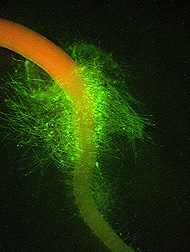Washington, DC
July 2, 2008
ARS News Service
Agricultural Research Service, USDA
By
Marcia Wood
|
 |
|
ARS researchers
are looking at varying abilities of bacteria
strains to grow on vegetables such as this
broccoli sprout, where green fluorescence
indicates the presence of Listeria monocytogenes
three days after innoculation in the lab.
Los investigadores del ARS están estudiando las
variaciones en la habilidad de cepas diferentes
de bacterias de crecer en verduras tales como
este brote de brécol, en el cual la
fluorescencia verde indica la presencia de la
bacteria Listeria monocytogenes tres días
después de la inoculación del brote en el
laboratorio.
Photo courtesy of Lisa A. Gorski. |
|
No one knows exactly how
microbes like Listeria monocytogenes or Salmonella
enterica can attach themselves to the bumpy leaves of a
cabbage or the ultra-fine root hairs of a tender young alfalfa
sprout.
It's a mystery that
Agricultural Research Service
(ARS) food safety scientists in Albany, Calif., are intent on
solving. The work, based at the ARS
Western Regional Research Center, may lead to new ways to
protect cabbage, sprouts and other salad favorites from attack
by foodborne pathogens.
Microbiologist
Lisa A. Gorski, for instance, led an investigation several
years ago that was the first to document the genes that L.
monocytogenes uses during a successful invasion of cabbage
leaves. Gorski did the work with Albany colleague
Jeffrey D. Palumbo and others.
Though scientists elsewhere had
looked at genes that this Listeria turns on--or
"expresses"--when it's grown on a bed of gel-like agar in a
laboratory, no one had, at the time of Gorski's investigation,
ever documented genes that this microbe expresses when it grows
on a vegetable.
Listeria is perhaps best known
for establishing colonies in humans, not on green plants. But
the team found that Listeria, when invading cabbage, calls into
play some of the same genes that plant-dwelling microbes
routinely use to colonize and spread harmlessly on plants.
In newer work, Gorski wants to
pinpoint genes responsible for the widely varying ability of
eight different Listeria strains to successfully colonize the
hair-thin strands, called root hairs, of alfalfa sprouts.
She's also interested in
studying, and disabling, genes that help some Listeria colonies
resist being washed off by water.
Read more about the research in the July 2008 issue of
Agricultural Research magazine.
ARS is a scientific research
agency of the U.S. Department of
Agriculture.
Nadie sabe exactamente cómo los
microbios tales como Listeria monocytogenes o
Salmonella enterica se pegan a las hojas de la col o las
raíces finas del brote de alfalfa.
Es un misterio que los
científicos del
Servicio de Investigación Agrícola (ARS) quieren resolver.
Su investigación, realizado en el
Centro de Investigación de la Región Occidental mantenido
por el ARS en Albany, California, podría llevar al
descubrimiento de nuevas maneras de proteger col, alfalfa y
otros ingredientes favoritos de la ensalada contra un ataque por
patógenos alimentarios.
Por ejemplo, microbióloga
Lisa A. Gorski encabezó una investigación hace varios años
que fue la primera en documentar los genes utilizados por L.
monocytogenes durante una invasión exitosa de las hojas de
col. Gorski realizó el trabajo en colaboración con microbiólogo
Jeffrey D. Palumbo y otros.
Aunque otros científicos han
estudiado los genes activados por L. monocytogenes cuando el
patógeno se crece en agar en el laboratorio, antes del estudio
por Gorski, no había ninguna documentación de los genes
expresados por el microbio durante su crecimiento en una
verdura.
Listeria es probablemente mejor
conocida por su habilidad de establecer colonias en humanos en
vez de en plantas. Pero el grupo de científicos en Albany
descubrió que Listeria, cuando invadiendo la col, utiliza
algunos de los mismos genes usados por los microbios de plantas
para colonizar sus huéspedes y extenderse inocuamente en las
plantas.
En nuevas investigaciones,
Gorski quiere identificar los genes responsables de las
habilidades ampliamente variadas de ocho cepas de Listeria de
colonizar exitosamente las raíces muy finas de la alfalfa.
Ella también tiene un interés
en estudiar, e incapacitar, los genes que ayudan a algunas
colonias de Listeria a resistir sacamiento por el agua.
Lea más sobre la investigación en la revista 'Agricultural
Research' de julio del 2008.
ARS es una agencia de
investigaciones científicas del
Departamento de
Agricultura de EE.UU. |